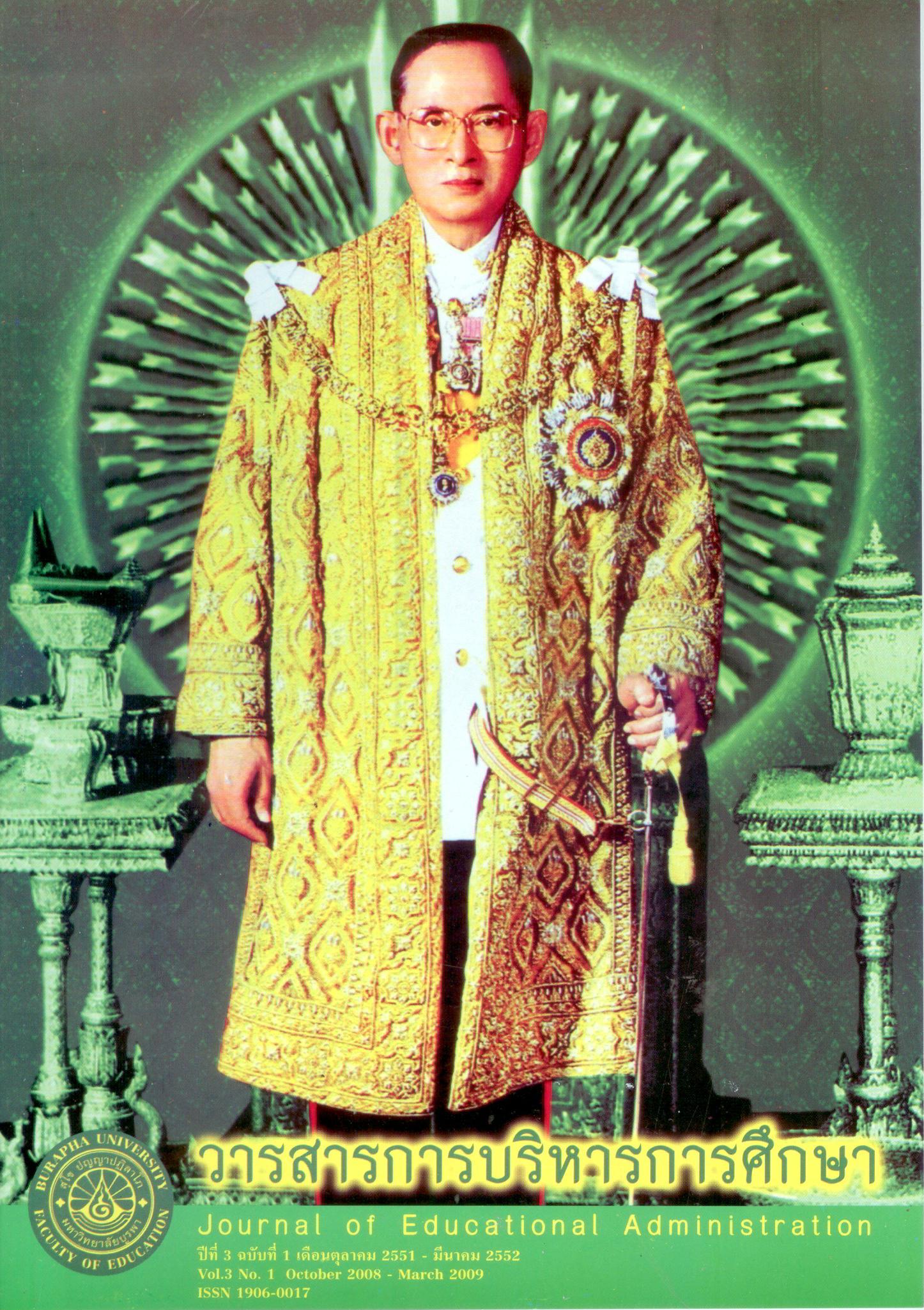รูปแบบการบริหารสู่ความเป็นเลิศของสถานศึกษา ขั้นพื้นฐานขนาดเล็ก (THE EDUCATIONAL ADMINISTRATION MODEL TOWARDS EXCELLENCE OF SMALL-SIZE EDUCATION INSTTTUTIONS)
Abstract
บทคัดย่อ
การวิจัยครั้งนี้มีจุดมุ่งหมายเพื่อเสนอรูปแบบการบริหารสู่ความเป็นเลิศของสถานศึกษาขั้นพื้นฐานขนาดเล็ก ขั้นตอนการวิจัยมี 4 ขั้นตอน คือ (1) การศึกษา วิเคราะห์องค์ประกอบการบริหารสู่ความเป็นเลิศของสถานศึกษาขั้นพื้นฐานขนาดเล็ก โดยการศึกษาสังเคราะห์เนื้อหา (Content Synthesis) จากเอกสารเกณฑ์การประเมินคุณภาพภายนอกของสถานศึกษาระดับการศึกษาขั้นพื้นฐานรอบที่สอง (พ.ศ.2549-2553) เกณฑ์การประเมินสถานศึกษาเพื่อรับรางวัลพระราชทานสำหรับสถานศึกษาของไทย การสังเคราะห์รางวัลสำหรับความเป็นเลิศสำหรับสถานศึกษาในฮ่องกง รางวัล Singapore Quality Award (SQA) สำหรับสถานศึกษาต่างประเทศและใช้วิธีวิเคราะห์ความคิดเห็นของผู้บริหารสถานศึกษาที่มีผลการประเมินภายนอก รอบแรก ระดับดี เป็นกลุ่มตัวอย่าง จำนวน 360 คน (2) การสร้างรูปแบบการบริหารสู่ความเป็นเลิศของ สถานศึกษาขั้นพื้นฐานขนาดเล็ก โดยการนำผลการศึกษาจากขั้นตอนแรกมากำหนดเป็นรูปแบบการบริหารสู่ความเป็นเลิศของสถานศึกษาขั้นพื้นฐานขนาดเล็ก ประกอบด้วยองค์ประกอบหลัก องค์ประกอบย่อยในแต่ละองค์ประกอบ และแนวปฏิบัติในแต่ละองค์ประกอบย่อยแล้วนำมาตรวจสอบความเหมาะสมและความเป็นไปได้ของรูปแบบการบริหารสู่ความเป็นเลิศของสถานศึกษาขั้นพื้นฐานขนาดเล็ก โดยผู้ทรงคุณวุฒิ จำนวน 17 คน (3) การทดลองใช้รูปแบบการบริหารสู่ความเป็นเลิศของสถานศึกษาขั้นพื้นฐานขนาดเล็กในสถานศึกษาที่มีคุณลักษณะตามเกณฑ์ จำนวน 6 แห่ง และ (4) การประเมินรูปแบบการบริหารสู่ความเป็นเลิศของสถานศึกษาขั้นพื้นฐานขนาดเล็ก โดยพิจารณาจากความคิดเห็นของผู้บริหารสถานศึกษาและครูในสถานศึกษาที่ทำการทดลองรูปแบบ จำนวน 18 คน
ผลการวิจัยพบว่า
1. องค์ประกอบของรูปแบบการบริหารสู่ความเป็นเลิศของสถานศึกษาขั้นพื้นฐานขนาดเล็ก ประกอบด้วยองค์ประกอบหลัก องค์ประกอบย่อย และแนวปฏิบัติในแต่ละองค์ประกอบ โดยองค์ประกอบของการบริหารสู่ความเป็นเลิศของสถานศึกษาขั้นพื้นฐาน ขนาดเล็ก มี 6 องค์ประกอบเรียงตามลำดับความสำคัญ คือ 1) พฤติกรรมการบริหารของผู้บริหารสถานศึกษา 2) การจัดองค์การ 3) การบริหารงานวิชาการ 4) การบริหารงบประมาณ 5) การบริหารงานบุคคลและ 6) การบริหารทั่วไปซึ่งทั้ง 6 องค์ประกอบมีองค์ประกอบย่อยทั้งหมด 23 องค์ประกอบย่อยและมีตัวแปรที่เกี่ยวข้องทั้งหมด 74 ข้อ
2. ผลการสร้างรูปแบบการบริหารสู่ความเป็นเลิศของสถานศึกษาขั้นพื้นฐานขนาดเล็กทำให้ได้แนวทางการดำเนินการที่แสดงความสัมพันธ์กันเชิงเหตุและผลไปในทิศทาง เดียวกันขององค์ประกอบ ประกอบด้วย 6 องค์ประกอบหลัก 23 องค์ประกอบย่อย และแนวปฏิบัติ จำนวน 68 ข้อ ในการบริหารจัดการที่มุ่งให้สถานศึกษาขนาดเล็กสู่ความเป็นเลิศ คือ มีการบริหารจัดการอย่างเป็นระบบสามารถจัดการศึกษา ทำให้นักเรียนมีคุณภาพสูงตามมาตรฐานที่กำหนด และสนองต่อความต้องการของชุมชน
3. รูปแบบการบริหารสู่ความเป็นเลิศของสถานศึกษาขั้นพื้นฐานขนาดเล็ก เมื่อนำไปทดลองใช้ในสถานการณ์จริง พบว่า ผู้บริหารสถานศึกษาและครูผู้สอนสามารถปฏิบัติตามรูปแบบที่กำหนดไว้ในคู่มือการใช้รูปแบบได้อย่างเป็นรูปธรรม เกิดผลต่อความเป็นเลิศของสถานศึกษา คือ มีการบริหารจัดการอย่างเป็นระบบมีแนวโน้มสามารถจัดการอย่างเป็นระบบมีแนวโน้มสามารถจัดการศึกษาทำให้นักเรียนมีคุณภาพสูงตามมาตรฐานที่กำหนดและสนองต่อความต้องการของชุมชน
4. ผลการประเมินตามรูปแบบการบริหารสู่ความเป็นเลิศของสถานศึกษาขั้นพื้นฐานขนาดเล็ก ที่พัฒนาขึ้นเป็นประโยชน์ มีความเป็นไปได้ มีความเหมาะสม และมีความถูกต้อง อยู่ในระดับมาก
ABSTRACT
The purpose of this research was to propose the educational administration model towards the excellence for small-sized educational institutions. This study is divided into four steps:
Step 1 : Study and analysis of components of administration for excellence of small-sized basic educational institutions by means of content for the 2nd basic educational institutions (BE 2549-2553), educational institution criteria for royal awards conferral for Thai educational institutions, and synthesis of awards for excellence of educational institutions in Hong Kong, Singapore Quality Award (SQA) for foreign educational institutions, and synthesis of opinions of 360 sample executives in educational institutions that received good first-round assessment.
Step 2: Development of the administration model towards excellence for small-sized educational institutions by taking the results from Step 1 to develop the model towards excellence for small-sized educational institutions, consisting of major and small components and guidelines in each small component, and then checking for suitability and feasibility of the administration model towards for small-sized educational institutions with 17 qualified experts.
Step 3 : Test of the administration model towards for small-sized educational institutions in six institutions.
Step 4 : Assessment of the administration model towards for small-sized educational institutions by considering opinions of 18 educational executives and teachers.
The findings of the research reveal that
1. Components of the administration model towards for small-size educational institutions comprised major and small components and guidelines in each component. The six major components in order of importance are (1) administrative behavior of institution executives, (2) organization, (3) academic administration, (4) budget administration, (5) personnel administration, and (6) general administration. All the six major components consist of 23 smaller components and 74 related variables.
2. Results of the development of the administration model towards for small-sized educational institutions reveal guidelines for positive causal relationship of the six major components and 23 smaller components and 68 guidelines for administration towards excellence, including systematic administration, ability to enhance students’ required standards, and response to community needs.
3. After testing the administration model towards for small-sized educational institutions in real situations, it was found that educational institutions’ executives and teachers were able to follow the model’s guidelines objectively, resulting in educational excellence, that is, systematic administration, potential ability to administer education to produce quality students according to the required standards, and response to community needs.
4. Assessments on the developed administration model towards for small-sized educational institutions proved to be useful, feasible, appropriate, and highly accurate.


